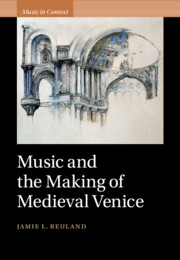Book contents
- Music and the Making of Medieval Venice
- Music in Context
- Music and the Making of Medieval Venice
- Copyright page
- Dedication
- Contents
- Figures
- Maps
- Tables
- Music Examples
- Acknowledgments
- Manuscript Sigla
- A Note on Dating
- Abbreviations
- Introduction
- Part I An Audible Empire
- Part II The Fictive City
- Part III Relics and the Horizons of Musical Representation
- 4 Narrative Fragments
- 5 History Lessons
- 6 Sound Documents
- Epilogue
- Book part
- Bibliography
- Index
4 - Narrative Fragments
Vespers for the Apparition of Saint Mark’s Relics
from Part III - Relics and the Horizons of Musical Representation
Published online by Cambridge University Press: 12 October 2023
- Music and the Making of Medieval Venice
- Music in Context
- Music and the Making of Medieval Venice
- Copyright page
- Dedication
- Contents
- Figures
- Maps
- Tables
- Music Examples
- Acknowledgments
- Manuscript Sigla
- A Note on Dating
- Abbreviations
- Introduction
- Part I An Audible Empire
- Part II The Fictive City
- Part III Relics and the Horizons of Musical Representation
- 4 Narrative Fragments
- 5 History Lessons
- 6 Sound Documents
- Epilogue
- Book part
- Bibliography
- Index
Summary
Chapter 4 examines one of the most spectacular music-liturgical programs of the fourteenth century: the narrative office for the feast of Saint Mark’s Apparition. A work of enormous rhetorical ingenuity and historical imagination, the Apparitio office, I argue, was a product of the state’s heightened attention to and generative engagement with the cult of relics. Found as a late addition to Basilica San Marco’s thirteenth-century antiphonal (VAM¹), the office celebrated the present-day virtue of the state’s most cherished possession: the body of its patron saint, the Evangelist Mark. Careful comparison between the Vespers office chants and the legend source from which the story derives reveals an inventive process of selection, omission, and invention of texts, and as well as a high degree of sensitivity in musical setting. The result was a compelling public ritual that represented the contract between the body of Mark and the Venetians who venerated him and, at the same time, made a self-reflexive bid for music and liturgy as the means for that contract’s renewal.
- Type
- Chapter
- Information
- Music and the Making of Medieval Venice , pp. 119 - 155Publisher: Cambridge University PressPrint publication year: 2023

